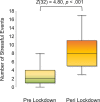Increases in Stressors Prior to-Versus During the COVID-19 Pandemic in the United States Are Associated With Depression Among Middle-Aged Mothers
- PMID: 34305763
- PMCID: PMC8292718
- DOI: 10.3389/fpsyg.2021.706120
Increases in Stressors Prior to-Versus During the COVID-19 Pandemic in the United States Are Associated With Depression Among Middle-Aged Mothers
Abstract
Working parents in are struggling to balance the demands of their occupation with those of childcare and homeschooling during the COVID-19 pandemic. Moreover, studies show that women are shouldering more of the burden and reporting greater levels of psychological distress, anxiety, and depression relative to men. However, research has yet to show that increases in psychological symptoms are linked to changes in stress during the pandemic. Herein, we conduct a small-N study to explore the associations between stress and psychological symptoms during the pandemic among mothers using structural equation modeling, namely latent change score models. Thirty-three mothers completed questionnaires reporting current anxious and depressive symptoms (Beck Anxiety and Depression Index, respectively), as well as stressful life experiences prior to-versus during the pandemic (Social Readjustment Rating Scale). Women endorsed significantly more stressful events during the pandemic, relative to the pre-pandemic period. Additionally, 58% of mothers scored as moderate-to-high risk for developing a stress-related physical illness in the near future because of their pandemic-level stress. Depressive symptoms were associated with the degree of change in life stress, whereas anxiety symptoms were more related to pre-pandemic levels of stress. The present study preliminarily sheds light on the nuanced antecedents to mothers' experiences of anxious and depressive symptoms during the COVID-19 pandemic. Although further work is needed in larger, more diverse samples of mothers, this study highlights the potential need for appropriate policies, and prevention and intervention programs to ameliorate the effects of pandemics on mothers' mental health.
Keywords: anxiety; coronavirus – COVID-19; depression; maternal; stress.
Copyright © 2021 Taylor, Frenzel, Johnson, Willett, White, Badura-Brack and Wilson.
Conflict of interest statement
The authors declare that the research was conducted in the absence of any commercial or financial relationships that could be construed as a potential conflict of interest.
Figures




Similar articles
-
Maternal depressive and anxiety symptoms before and during the COVID-19 pandemic in Canada: a longitudinal analysis.Lancet Psychiatry. 2021 May;8(5):405-415. doi: 10.1016/S2215-0366(21)00074-2. Epub 2021 Mar 24. Lancet Psychiatry. 2021. PMID: 33773109 Free PMC article.
-
Mediating mechanisms for maternal mental health from pre- to during the COVID-19 pandemic: Mediators of maternal mental illness during COVID-19.J Affect Disord Rep. 2021 Dec;6:100287. doi: 10.1016/j.jadr.2021.100287. Epub 2021 Nov 29. J Affect Disord Rep. 2021. PMID: 34881379 Free PMC article.
-
COVID-19 Pandemic Experiences and Symptoms of Pandemic-Associated Traumatic Stress Among Mothers in the US.JAMA Netw Open. 2022 Dec 1;5(12):e2247330. doi: 10.1001/jamanetworkopen.2022.47330. JAMA Netw Open. 2022. PMID: 36525271 Free PMC article.
-
Uptrend in distress and psychiatric symptomatology in pregnant women during the coronavirus disease 2019 pandemic.Acta Obstet Gynecol Scand. 2020 Jul;99(7):848-855. doi: 10.1111/aogs.13925. Epub 2020 Jun 3. Acta Obstet Gynecol Scand. 2020. PMID: 32449178
-
Depression and anxiety among pregnant mothers in the initial stage of the Coronavirus Disease (COVID-19) pandemic in the southwest of Iran.Reprod Health. 2021 Jun 4;18(1):111. doi: 10.1186/s12978-021-01167-y. Reprod Health. 2021. PMID: 34088329 Free PMC article.
Cited by
-
Dealing with the challenges of the pandemic - results of a population-based survey during the second year of the COVID-19 pandemic contrasting benefits and burden.BMC Public Health. 2024 Jul 19;24(1):1941. doi: 10.1186/s12889-024-19203-4. BMC Public Health. 2024. PMID: 39030540 Free PMC article.
-
Home-schooling and caring for children during the COVID-19 lockdown in the UK: emotional states, systems of support and coping strategies in working mothers.Front Sociol. 2024 Mar 21;9:1168465. doi: 10.3389/fsoc.2024.1168465. eCollection 2024. Front Sociol. 2024. PMID: 38577242 Free PMC article.
-
Increases in Circulating Cortisol during the COVID-19 Pandemic are Associated with Changes in Perceived Positive and Negative Affect among Adolescents.Res Child Adolesc Psychopathol. 2022 Dec;50(12):1543-1555. doi: 10.1007/s10802-022-00967-5. Epub 2022 Sep 1. Res Child Adolesc Psychopathol. 2022. PMID: 36048374 Free PMC article.
-
Parental stress and physical violence against children during the second year of the COVID-19 pandemic: results of a population-based survey in Germany.Child Adolesc Psychiatry Ment Health. 2023 Feb 20;17(1):25. doi: 10.1186/s13034-023-00571-5. Child Adolesc Psychiatry Ment Health. 2023. PMID: 36804027 Free PMC article.
-
COVID-19 Pandemic in Portugal: Psychosocial and Health-Related Factors Associated with Psychological Discomfort.Int J Environ Res Public Health. 2022 Mar 15;19(6):3494. doi: 10.3390/ijerph19063494. Int J Environ Res Public Health. 2022. PMID: 35329180 Free PMC article.
References
-
- Alon T., Doepke M., Olmstead-Rumsey J., Tertilt M. (2020). The Impact of COVID-19 on Gender Equality. Cambridge, MA: National Bureau of Economic Research.
-
- Beck A. T., Brown G., Epstein N., Steer R. A. (1988). An inventory for measuring clinical anxiety: psychometric properties. J. Couns. Clin. Psychol. 56, 893–897. - PubMed
-
- Beck A. T., Steer R. A., Brown G. (1996). Beck depression inventory–II. Psychol. Assess. 10.1037/t00742-000 - DOI
-
- Benassi E., Vallone M., Camia M., Scorza M. (2020). Women during the Covid-19 lockdown: more anxiety symptoms in women with children than without children and role of the resilience. Mediterr. J. Clin. Psychol. 8. 10.6092/2282-1619/mjcp-2559 - DOI
Grants and funding
LinkOut - more resources
Full Text Sources

